Hello friends, it’s Nazia here, coming to you from the test kitchen at Food and Meal. Lately I’ve been on a mission to expand my culinary horizons and explore new flavors from around the world. And let me tell you, this journey continues to fill my heart with so much joy.
Today I’m taking inspiration from the vibrant flavors of Korean cuisine. I’ll be whipping up a vegetarian version of the classic Korean mixed rice bowl, loaded with a rainbow of fresh vegetables. What draws me to this dish is how the ingredients work together to create a beautifully balanced and healthy meal.
The nutty brown rice, crunchy vegetables, savory shiitake mushrooms, and sunny side up egg all combine for a bowl packed with different textures. And the sweet and salty gochujang sauce brings everything together. I’m so excited to jump into the kitchen and let these new flavors spark my creativity.
As I chop and stir, I hope the aromas of garlic, sesame, and gochujang will transport me right to the streets of Seoul. With each new dish, I get to experience culture and tradition from the inside out. That’s the true magic of cooking for me. It’s so much more than just food on a plate.
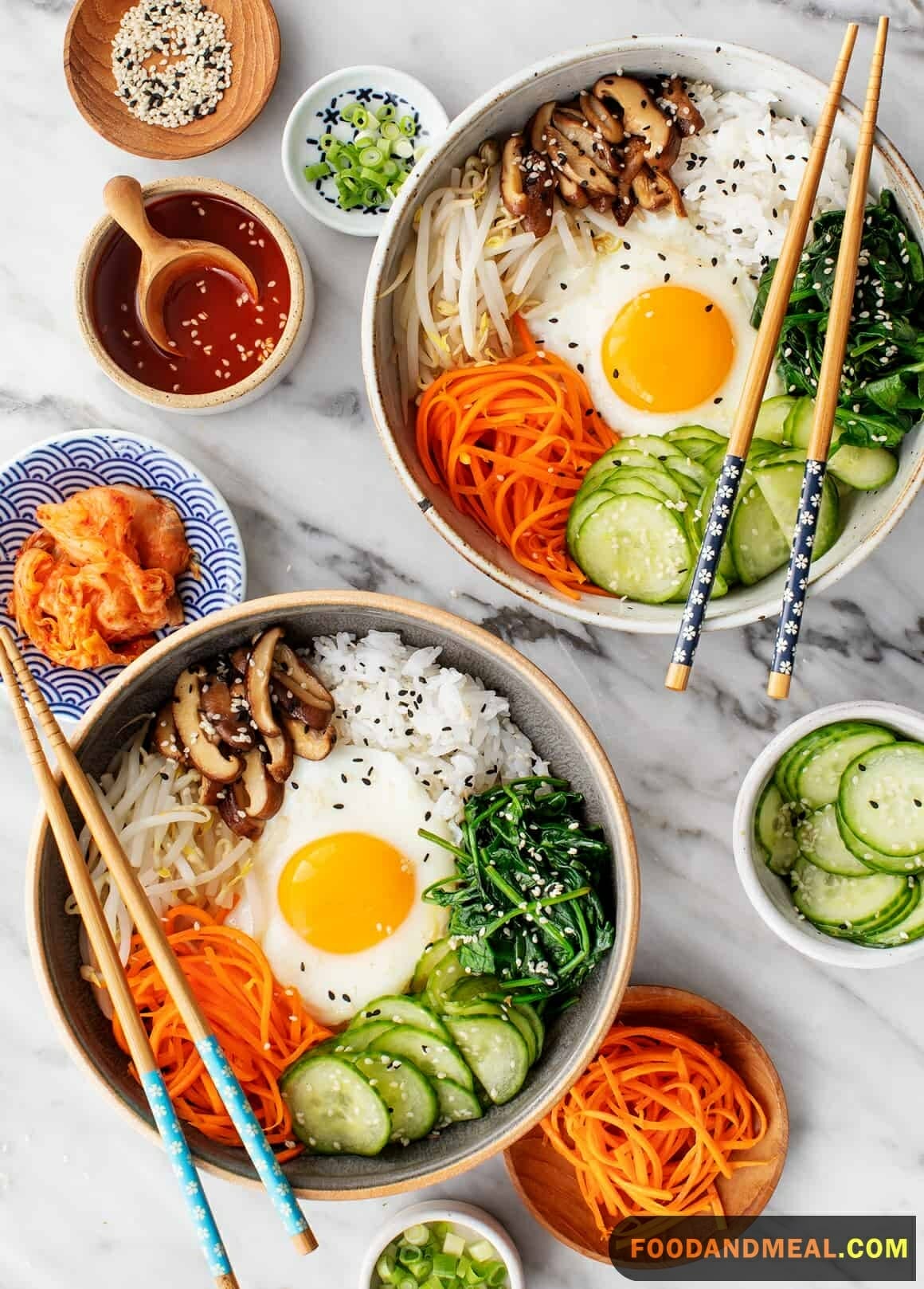
Korean Mixed Rice with Vegetables Recipe
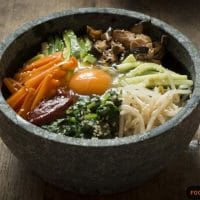
MIXED RICE WITH VEGETABLES
Equipment
Ingredients
For the sauce
- 3 tablespoons gochujang or gluten-free gochujang
- 2 tablespoons mirin
- 1 tablespoon sugar
- 2 teaspoons sesame seeds
- 1 teaspoon toasted sesame oil
For the mixed rice
- Salt
- 1 1/2 cups baby spinach, parboiled and squeezed of excess liquid
- 4 tablespoons plus 1⁄2 teaspoon toasted sesame oil, divided
- 1 tablespoon sesame seeds
- 1 1/2 cups bean sprouts, parboiled and squeezed of excess liquid
- 1 medium carrot, cut into matchsticks
- 4 shiitake mushrooms, thinly sliced
- 1 medium zucchini, thinly sliced
- 5 cups cooked rice
- 4 eggs, fried sunny-side up
- 2 tablespoons sesame oil, for serving
Instructions
TO MAKE THE SAUCE
- In a small bowl, stir together the gochujang, mirin, sugar, sesame seeds, and sesame oil. Mix well and set aside.
TO MAKE THE MIXED RICE
- In a medium bowl, prepare a saltwater bath by adding 3 tablespoons of salt to 2 cups of ice water. Immerse the cucumber slices in the bath for 20 minutes and then drain. Squeeze out excess water with your hands.
- In a small bowl, season the spinach with 2 teaspoons of the sesame oil, 1 teaspoon salt, and a 1⁄4 teaspoon of the sesame seeds. Set aside.
- In a small bowl, season the bean sprouts with 11⁄2 teaspoons of the sesame oil and 1 teaspoon salt. Set aside.
- In a medium skillet over medium heat, heat 1 teaspoon of the sesame oil. Add the carrots and a dash of salt, and sauté 1 to 2 minutes, until the carrots are crisp-tender. Remove the carrots and set aside.
- Add another teaspoon of the sesame oil to the skillet. Add the mushrooms and a dash of salt, and sauté the mushrooms for 1 to 2 minutes until tender. Remove the mushrooms and set aside.
- Add another teaspoon of the sesame oil to the skillet. Add the zucchini and a dash of salt, and sauté the zucchini for 1 to 2 minutes, until the slices are crisp-tender. Remove the zucchini and set aside.
- Divide the cooked rice in 4 large bowls and arrange the vegetables on top.
- Place an egg on top of the vegetables and rice.
- Garnish each egg with a pinch of sesame seeds.
- Serve with the sauce and remaining sesame oil.
- To eat, drizzle the bibimbap sauce and 1⁄2 tablespoon sesame oil over the vegetables and egg, and mix everything together with a spoon.
Video
Notes
VARIATION TIP: To make dolsot bibimbap, spread sesame oil over the inside of large earthenware bowls (see here to read about dolsot bowls), place the rice inside with vegetables on top, and then heat the bowls on the stove over high heat until the rice begins to make crackling sounds. Top the vegetables with the eggs, remove from the heat, and serve immediately
Nutrition
© Food And Meal
This website provides approximate nutrition information for convenience and as a courtesy only. Nutrition data is gathered primarily from the Spoonacular Database, whenever available, or otherwise other online calculators.
Cooking Tips
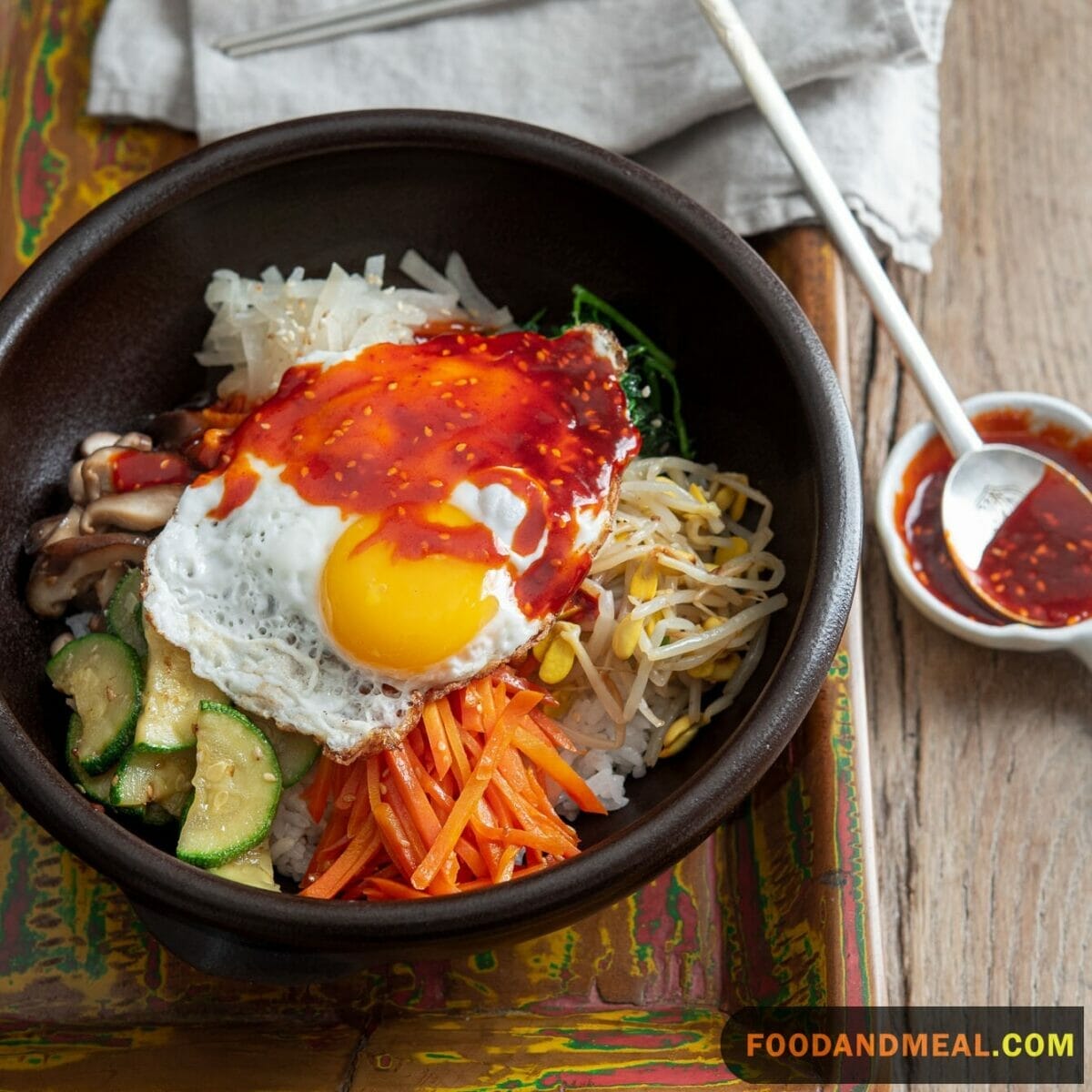
First, don’t be intimidated by the gochujang (Korean red chili paste)! I’ll admit I was a bit nervous to cook with this totally new ingredient at first. But really, it adds the most wonderful sweet, savory and spicy kick. Just start with a couple tablespoons and adjust from there to your desired level of heat.
Chopping all the vegetables into small, uniform pieces ensures every bite is balanced. I especially loved the combination of crisp bell pepper, earthy spinach and woodsy shiitakes. But feel free to switch up the veggies to your favorites!
When it comes to the brown rice, make sure not to overcook it so it stays nice and chewy. I think the texture pairs so nicely with the saucy vegetables. And don’t forget to top it off with a runny fried egg for extra creaminess.
Most importantly, have fun with this dish! Add your own creative spin, play with different ingredient combos and seasonings. My exploration of flavors from around the world fills me with so much happiness when I cook. I hope making this Korean mixed rice brings you joy too!
Serving Suggestions
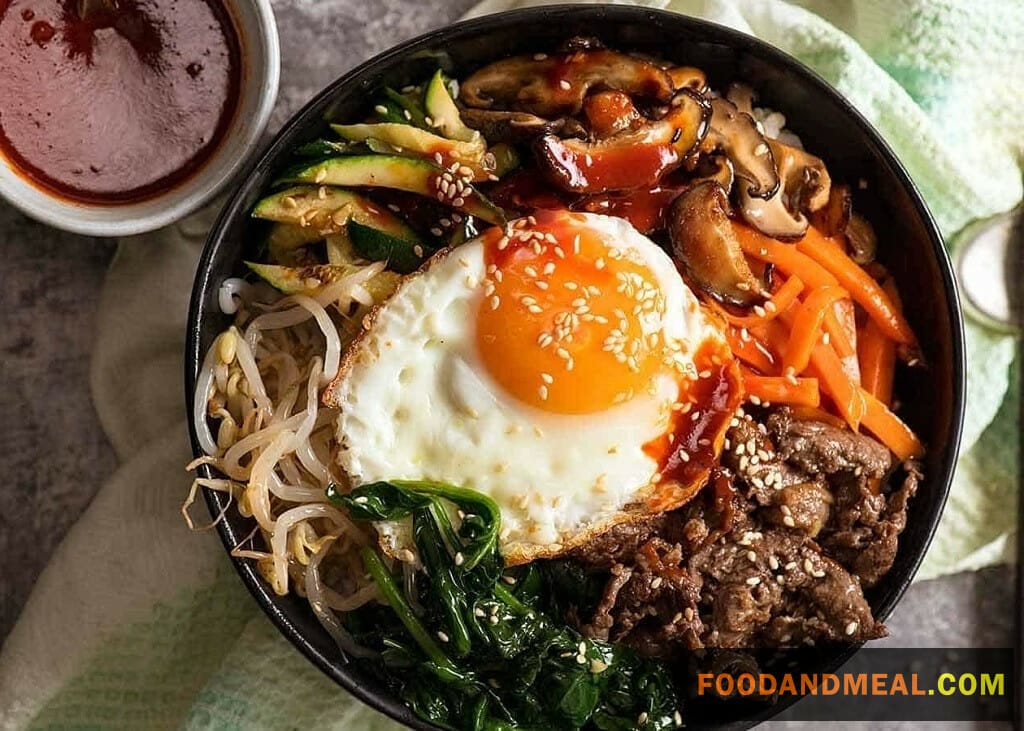
My exploration of Korean flavors has me hungry to try even more dishes to pair with this wonderful mixed rice! Here are some serving suggestions using ingredients commonly found in Korean cuisine:
Try topping your rice bowl with karaage, Japanese-style fried chicken. The crispy exterior and juicy chicken would contrast nicely with the mixed veggies. For extra flavor, season the karaage with some gochujang sauce.
For a vegetarian protein, marinated and pan-fried tofu cubes would be delicious. Their soft, pillowy texture will soak up the sweet and spicy sauce. Fried eggs also make a quick protein and the runny yolks will create even more creaminess.
If you love seafood, a simple sesame oil-based tuna or salmon sashimi would beautifully complement the rice. The pure, fresh flavors highlight instead of overpower the vegetables and gochujang.
For something warm and comforting, add a soft boiled soy egg or spicy braised eggs. Let the luscious yolks mix into the rice for extra richness.
And don’t forget a bowl of miso soup on the side! This classic complements any Korean meal.
FAQs of Mixed Rice with Vegetables
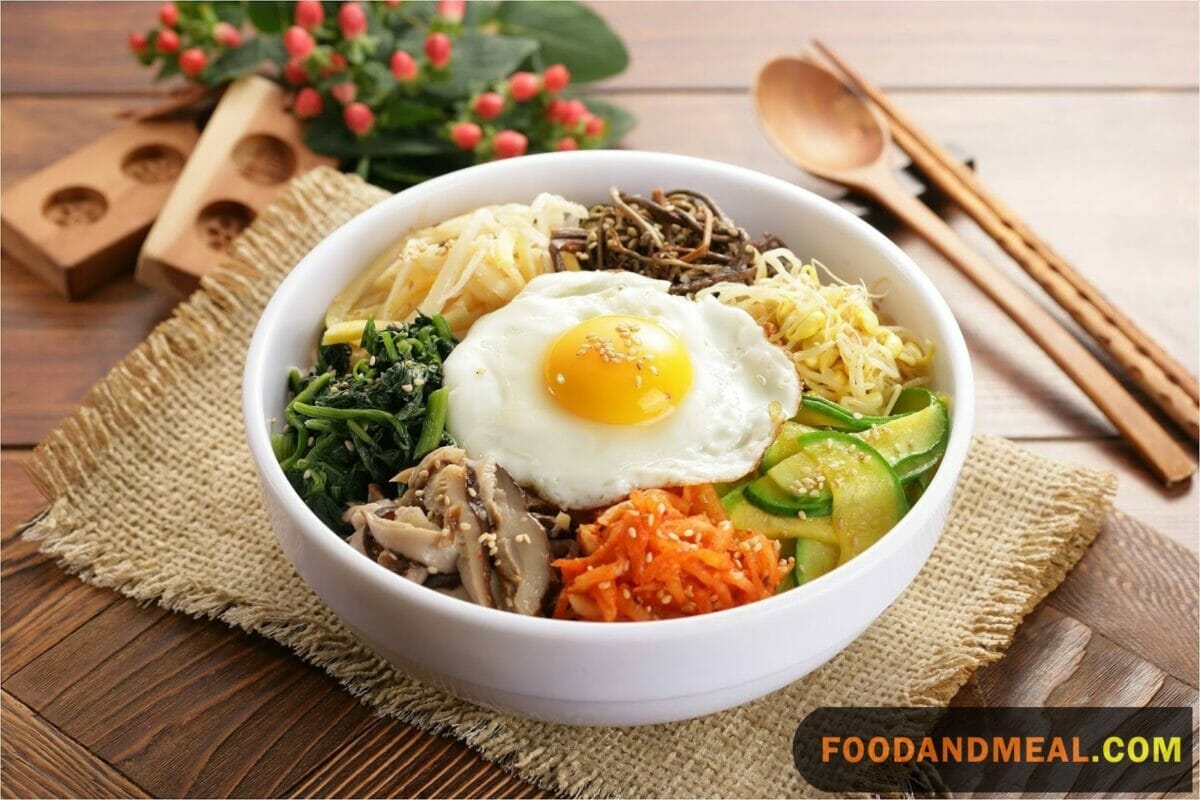
- Can I use brown rice instead of white?
Absolutely! Brown rice offers a nuttier flavor and can be a healthier alternative. Just adjust the cooking time as brown rice tends to take a bit longer. - What if I don’t have all the vegetables listed?
The beauty of this dish lies in its flexibility. Use what you have on hand. Just aim for a mix of colors and textures. - How spicy is this dish?
It’s all up to you. Adjust the amount of gochujang (Korean chili paste) to your liking. Remember, it’s easier to add more than to dial it back. - How do I store the leftovers?
Store any leftovers in an airtight container in the refrigerator. It should keep well for 2-3 days. When reheating, a quick stir in a pan or a short blast in the microwave should do the trick. - Can I add meat or tofu to the dish?
Certainly! Sliced beef, chicken, or firm tofu can be marinated in a mix of soy sauce, garlic, and a touch of sesame oil, then sautéed and added to the mix.
Conclusion
As I close out this blog post, I’m filled with so much gratitude for the opportunity to explore new flavors and dishes with all of you. Cooking this wonderful Korean mixed rice truly fed my soul and opened my eyes to new culinary horizons.
I hope my tips, suggestions and serving ideas have inspired you to step outside your comfort zone in the kitchen too. Don’t be afraid to experiment with new ingredients like gochujang or get creative mixing vegetables and proteins. Approach cooking with an open heart and mind, just as you would a new culture or cuisine.
This is just the start of my flavor adventures – I can’t wait to see where food takes me next! If Korean mixed rice sparked your interest, stay tuned to the Food and Meal blog for more ethnic recipe inspirations. And as always, please share your own kitchen stories with me. I love hearing from you!
Hi! I'm Nazia of ‘Nazia Cooks’, a self-taught baker and cook residing in Chennai. Rooted in the rich South Indian culinary landscape, my palate has expanded to embrace global flavors. I revel in crafting fusion dishes, melding traditions to birth unique tastes.



